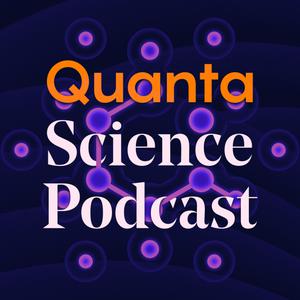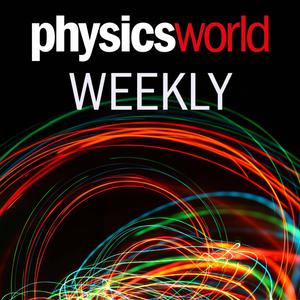
Breaking Math Podcast
Gabriel Hesch and Autumn Phaneuf
Hosted by Gabriel Hesch and Autumn Phaneuf, who have advanced degrees in EE and industrial engineering/operations research respectively, come together to discuss mathematics as a pure field al in its own as well as how it describes the language of science, engineering, and even creativity. Breaking Math brings you the absolute best in interdisciplinary science discussions - bringing together experts in varying fields including artificial intelligence, neuroscience, evolutionary biology, physics, chemistry and materials-science, and more - to discuss where humanity is headed.website: breakingmath.io linktree: linktree.com/breakingmathmediaemail: [email protected]
- 41 minutes 8 secondsHow Analytics Can Revolutionize Affordable Energy
In this episode, Dr. Destine Nock, CEO of Peoples Energy Analytics and a Professor at Carnegie Mellon University, joins Autumn to dive deep into the world of energy equity. They explore how cutting-edge data analytics are revolutionizing the landscape of affordable energy access. As the global demand for sustainable energy solutions continues to grow, the need to ensure fair and inclusive energy distribution becomes more critical than ever. Together, our hosts break down how data-driven insights are being leveraged to develop and implement policies that make energy more accessible to underserved communities, tearing down socioeconomic barriers and paving the way for a more equitable future.
Dr. Nock and Autumn discuss the powerful role that advanced analytics play in everything from analyzing consumption patterns to optimizing renewable energy distribution. They explore real-world case studies, highlight key initiatives, and speak with experts who are at the forefront of these transformative efforts. By the end of this episode, you’ll understand how strategic use of data can drive lasting change and help us build a world where energy is not a privilege but a right accessible to all.
Subscribe to Breaking Math wherever you get your podcasts.Become a patron of Breaking Math for as little as a buck a month
Follow Dr. Destenie Nock on LinkedIn and on her website. Check out Peoples Energy Analytics as well.
Follow Breaking Math on Twitter, Instagram, LinkedIn, Website, YouTube, TikTokFollow Autumn on Twitter and Instagram
Follow Gabe on Twitter.
Become a guest here
email: [email protected]
19 November 2024, 5:36 am - 13 minutesWhat is Chaos Theory?
In this captivating episode of Breaking Math, hosts Gabriel and Autumn dive deep into chaos theory—a fascinating branch of mathematics that explores the behavior of complex systems highly sensitive to initial conditions. They break down the butterfly effect, revealing how tiny variations can lead to major consequences and discuss the inherent unpredictability in weather forecasting and the financial markets. The episode also uncovers chaos theory’s influence on human physiology, such as heart rate variability, and the mathematical beauty of fractals. Additionally, the hosts explore philosophical viewpoints, emphasizing how accepting life’s uncertainties can foster adaptability and resilience.
Key Takeaways:
Chaos Theory: Small actions can trigger significant outcomes, impacting everything from nature to human-made systems.
Butterfly Effect: Demonstrates how tiny differences in initial conditions can lead to vastly different outcomes.
Weather Forecasting: An excellent real-world illustration of chaos theory, showing how unpredictable weather can be.
Financial Markets: A reminder of the chaotic, complex forces that drive economic shifts and unpredictability.
Human Physiology: Chaos theory sheds light on natural processes, like the variability of heart rhythms.
Fractals: These intricate patterns showcase self-similarity and are visually striking examples of chaos in nature.
Philosophical Implications: Embracing chaos and uncertainty equips us to be more adaptable and creative.
Life's Unpredictability: A reflection of chaotic systems, reminding us to value flexibility. Interconnectedness: Understanding chaos theory enhances our appreciation of how interwoven our world truly is.
Keywords: Chaos Theory, Butterfly Effect, Weather Forecasting, Economics, Fractals, Unpredictability, Complex Systems, Human Physiology, Philosophical Implications, Adaptability.
Become a patron of Breaking Math for as little as a buck a month
Follow Breaking Math on Twitter, Instagram, LinkedIn, Website, YouTube, TikTok
Follow Autumn on Twitter and Instagram
Follow Gabe on Twitter.
Become a guest here
email: [email protected]
12 November 2024, 5:03 am - 12 minutes 11 secondsAI in the Lab: How GPT-4 is Changing Molecules and Models
In this episode of Breaking Math, we dive deep into the transformative power of large language models (LLMs) like GPT-4 in the fields of chemistry and materials science, based on the article "14 examples of how LLMs can transform materials science and chemistry: a reflection on a large language model hackathon" by Jablonka et al. from the Digital Discovery Journal. Discover how AI is revolutionizing scientific research with predictive modeling, lab automation, natural language interfaces, and data extraction from research papers. We explore how these models are streamlining workflows, accelerating discovery, and even reshaping education with personalized AI tutors.
Tune in to learn about real-world examples from a hackathon where scientists used LLMs to tackle some of the most pressing challenges in materials science and chemistry—and what this means for the future of scientific innovation.
Keywords: GPT-4, large language models, AI in chemistry, AI in materials science, predictive modeling, lab automation, AI in education, natural language processing, LLM hackathon, scientific research, molecular properties, Digital Discovery Journal, Jablonka
Become a patron of Breaking Math for as little as a buck a monthFollow Breaking Math on Twitter, Instagram, LinkedIn, Website, YouTube, TikTok
Follow Autumn on Twitter and Instagram
Follow Gabe on Twitter.
Become a guest here
email: [email protected]
5 November 2024, 5:04 am - 15 minutes 8 secondsThe Fluid Dynamics of Sheep
In this episode of Breaking Math, we explore the unexpected link between sheep herding and fluid dynamics! Did you know that the way sheep move in a herd is governed by the same mathematical principles as water flowing in a river? By following simple rules of alignment, cohesion, and separation, sheep create a coordinated, fluid-like movement that scientists can model to predict behavior.
Join us as we break down how these principles apply not only to animal herds but also to real-world applications like robotics, autonomous vehicles, and crowd management. Whether you're a math lover, curious about animal behavior, or fascinated by the science behind traffic flow, this episode reveals the incredible power of mathematics in nature. Don’t forget to subscribe for more insights into the surprising connections between math and the world around us!
Timestamps:
00:00 - Introduction to Sheep Herding and Fluid Dynamics
02:15 - What is Fluid Dynamics?
06:30 - How Sheep Behave Like Particles in a Fluid
10:45 - Mathematical Models of Herding Behavior
16:20 - Real-world Applications: From Farming to Robotics
20:55 - Conclusion & Key TakeawaysTags: #BreakingMath #FluidDynamics #AnimalBehavior #MathInNature #SheepHerding #Robotics #ScienceExplained #EmergentBehavior
Become a patron of Breaking Math for as little as a buck a monthFollow Breaking Math on Twitter, Instagram, LinkedIn, Website, YouTube, TikTok
Follow Autumn on Twitter and Instagram
Follow Gabe on Twitter.
Become a guest here
email: [email protected]
29 October 2024, 4:03 am - 8 minutes 6 secondsThe Discovery of the Largest Prime Number: M136279841
In this exciting episode of Breaking Math, we explore the groundbreaking discovery of the largest prime number ever found—M136279841, a Mersenne prime with over 41 million digits! Join us as we dive deep into the story behind this astonishing mathematical achievement, led by Luke Durant, a volunteer from the Great Internet Mersenne Prime Search (GIMPS) project.
Discover how Mersenne primes work, why they’re so important to the world of mathematics, and how cutting-edge technology like GPUs has revolutionized the search for these massive numbers. We also discuss the critical role that prime numbers play in cryptography and online security, making this discovery relevant far beyond just the realm of theoretical mathematics.
Learn about the global collaborative effort that made this record-breaking discovery possible, and find out how you can join the hunt for the next giant prime! Whether you're a math enthusiast, a tech geek, or just curious about the wonders of numbers, this episode is packed with insights that will inspire you to think about prime numbers in a whole new way.
Key Takeaways:
- The discovery of M136279841, a prime number with 41,024,320 digits.
- The role of Luke Durant and the GIMPS project in pushing the boundaries of prime number research.
- How GPUs are transforming the way we discover massive primes.
- The importance of prime numbers in modern cryptography and technology.
- The connection between Mersenne primes and perfect numbers.
Links Mentioned:
- Join the GIMPS project and search for the next prime: www.mersenne.org/download
- Learn more about Mersenne primes: Mersenne Prime History
Become a patron of Breaking Math for as little as a buck a month
Follow Breaking Math on Twitter, Instagram, LinkedIn, Website, YouTube, TikTok
Follow Autumn on Twitter and Instagram
Follow Gabe on Twitter.
Become a guest here
email: [email protected]
22 October 2024, 5:51 am - 10 minutes 48 secondsExploring GFlowNets and AI-Driven Material Discovery for Carbon Capture
In this episode of Breaking Math, hosts Gabriel Hesch and Autumn Phaneuf dive into the cutting-edge world of Generative Flow Networks (GFlowNets) and their role in artificial intelligence and material science. The discussion centers on how GFlowNets are revolutionizing the discovery of new materials for carbon capture, offering a powerful alternative to traditional AI models. Learn about the mechanics of GFlowNets, their advantages, and the groundbreaking results in developing materials with enhanced CO2 absorption capabilities. The episode also explores the future potential of GFlowNets in AI-driven material discovery and beyond, emphasizing their transformative impact on carbon capture technology and sustainable innovation.
Become a patron of Breaking Math for as little as a buck a month
You can find the paper “Discovery of novel reticular materials for carbon dioxide capture using GFlowNets” by Cipcigan et al in Digital Discovery Journal by the Royal Society of Chemistry.Follow Breaking Math on Twitter, Instagram, LinkedIn, Website, YouTube, TikTok
Follow Autumn on Twitter and Instagram
Follow Gabe on Twitter.
Become a guest here
email: [email protected]
22 October 2024, 4:19 am - 23 minutes 25 secondsVictorian Era Spooky Scientists & Paranormal Activity
Explore the intriguing intersection of science and spiritualism in the Victorian era. This episode uncovers how prominent scientists like Michael Faraday, William James, and Marie & Pierre Curie engaged with supernatural phenomena and the rise of spiritualism. Discover the scientific efforts to debunk or understand paranormal activities, and how these investigations shaped modern science. Dive into the fascinating legacy of this 19th-century movement and its lasting impact on today's scientific inquiries into the unknown. Perfect for fans of history, science, and the supernatural.
Keywords: Victorian era, spiritualism, science, supernatural, Michael Faraday, William James, Alfred Russell Wallace, Curies, Eleanor Sidgwick, idiomotor effect
Become a patron of Breaking Math for as little as a buck a monthFollow Breaking Math on Twitter, Instagram, LinkedIn, Website, YouTube, TikTok
Follow Autumn on Twitter and Instagram
Follow Gabe on Twitter.
Become a guest here
email: [email protected]
15 October 2024, 4:54 am - 33 minutes 22 secondsIs AI Conscious?
AI & Consciousness: Philosophical Debates, Ethical Implications & the Future of Conscious Machines
In this episode of Breaking Math, hosts Autumn and Gabriel explore the intricate relationship between artificial intelligence (AI) and consciousness. Delve into historical perspectives, philosophical debates, and the ethical questions surrounding the creation of conscious machines. Key topics include the evolution of AI, challenges in defining and testing consciousness, and the potential rights of AI beings. We also examine the Turing Test, the debate between strong AI vs. weak AI, and concepts like personhood and integrated information theory. Perfect for anyone interested in AI ethics, the nature of consciousness, and the responsibilities of advanced AI technology.
Keywords: AI, consciousness, Turing test, strong AI, weak AI, ethics, philosophy, personhood, integrated information theory, neural networks
Become a patron of Breaking Math for as little as a buck a monthFollow Breaking Math on Twitter, Instagram, LinkedIn, Website, YouTube, TikTok
Follow Autumn on Twitter and Instagram
Follow Gabe on Twitter.
Become a guest here
email: [email protected]
8 October 2024, 4:07 am - 28 minutes 23 secondsMolecular dynamics simulation with GFlowNets: machine learning the importance of energy estimators in computational chemistry and drug discovery
In this episode of Breaking Math, hosts Autumn and Gabriel take a deep dive into the paper “Towards Equilibrium Molecular Conformation Generation with GFlowNets” by Volokova et al., published in the Digital Discovery Journal by the Royal Society of Chemistry. They explore the cutting-edge intersection of molecular conformations and machine learning, comparing traditional methods like molecular dynamics and cheminformatics with the innovative approach of Generative Flow Networks (GFlowNets) for molecular conformation generation.
The episode covers empirical results that showcase the effectiveness of GFlowNets in computational chemistry, their scalability, and the role of energy estimators in advancing fields like drug discovery. Tune in to learn how machine learning is transforming the way we understand molecular structures and driving breakthroughs in chemistry and pharmaceuticals.
Keywords: molecular conformations, machine learning, GFlowNets, computational chemistry, drug discovery, molecular dynamics, cheminformatics, energy estimators, empirical results, scalability, math, mathematics, physics, AI
Become a patron of Breaking Math for as little as a buck a month
You can find the paper “Towards equilibrium molecular conformation generation with GFlowNets” by Volokova et al in Digital Discovery Journal by the Royal Society of Chemistry.Follow Breaking Math on Twitter, Instagram, LinkedIn, Website, YouTube, TikTok
Follow Autumn on Twitter and Instagram
Follow Gabe on Twitter.
Become a guest here
email: [email protected]
1 October 2024, 4:34 am - 56 minutes 26 secondsDo Plants Know Math?
Mathematical Patterns in Plants: Fibonacci, Golden Ratio & Nature's Hidden Math with Christophe Gole & Nancy Pick
In this episode of Breaking Math, host Autumn interviews authors Christophe Gole and Nancy Pick about the captivating world of mathematical patterns in plants, inspired by their book Do Plants Know Math?. Explore the intersection of mathematics and biology as they discuss the Fibonacci sequence, the golden ratio, and spiral formations that reveal nature's mathematical beauty. Learn about the optimization of plant structures, the role of women in mathematics, and get recommendations for further reading. Topics include phyllotaxis, fractals, and their connections to AI, physics, and topology.
Keywords: mathematics, biology, plant math, Fibonacci, phylotaxis, spirals, golden ratio, fractals, nature, science, women in math,topology, ai, physics, math, plants, gardening
Become a patron of Breaking Math for as little as a buck a month
You can connect with Christophe Gole and Nancy Pick on LinkedIn, and find their Book “Do Plants Know Math?” on Amazon.Follow Breaking Math on Twitter, Instagram, LinkedIn, Website, YouTube, TikTok
Follow Autumn on Twitter and Instagram
Follow Gabe on Twitter.
Become a guest here
email: [email protected]
24 September 2024, 4:05 am - 57 minutes 59 secondsMapmatics: A Mathematician's Guide to Navigating the World with Maps with Paulina Rowinska
Math & Cartography: Dr. Paula Rowinska on Map Projections, Gerrymandering & Real-World Math
In this episode of Breaking Math, host Autumn interviews Dr. Paula Rowinska about her unique journey from earning a PhD in mathematics to writing about math and cartography. They discuss the fascinating connection between map-making and mathematics, debunking misconceptions about map projections and exploring key topics like the coastline paradox, gerrymandering, and the traveling salesman problem. Learn how these mathematical concepts play a crucial role in areas like crime analysis, geopolitics, and more. Perfect for enthusiasts of math, cartography, and real-world problem-solving.The conversation also celebrates the contributions of underrepresented women in mathematics and underscores the importance of math in everyday life. Tune in to discover how mathematics shapes our understanding of the world through cartography, topology, and even AI.
Keywords: mathematics, cartography, map projections, coastline paradox, gerrymandering, women in math, traveling salesman problem, crime analysis, topology, metric map, ai, physics, math
Become a patron of Breaking Math for as little as a buck a month
Follow Dr. Paula Rowinska at paulinarowinska.com and @PaulaRowinska on Twitter. You can also find her book Mapmatics on Amazon.Follow Breaking Math on Twitter, Instagram, LinkedIn, Website, YouTube, TikTok
Follow Autumn on Twitter and Instagram
Follow Gabe on Twitter.
Become a guest here
email: [email protected]
17 September 2024, 4:12 am - More Episodes? Get the App
Your feedback is valuable to us. Should you encounter any bugs, glitches, lack of functionality or other problems, please email us on [email protected] or join Moon.FM Telegram Group where you can talk directly to the dev team who are happy to answer any queries.
 Quanta Science Podcast
Quanta Science Podcast
 Physics World Weekly Podcast
Physics World Weekly Podcast
 Sean Carroll's Mindscape: Science, Society, Philosophy, Culture, Arts, and Ideas
Sean Carroll's Mindscape: Science, Society, Philosophy, Culture, Arts, and Ideas
 The Numberphile Podcast
The Numberphile Podcast
 Why This Universe?
Why This Universe?
 The Joy of Why
The Joy of Why